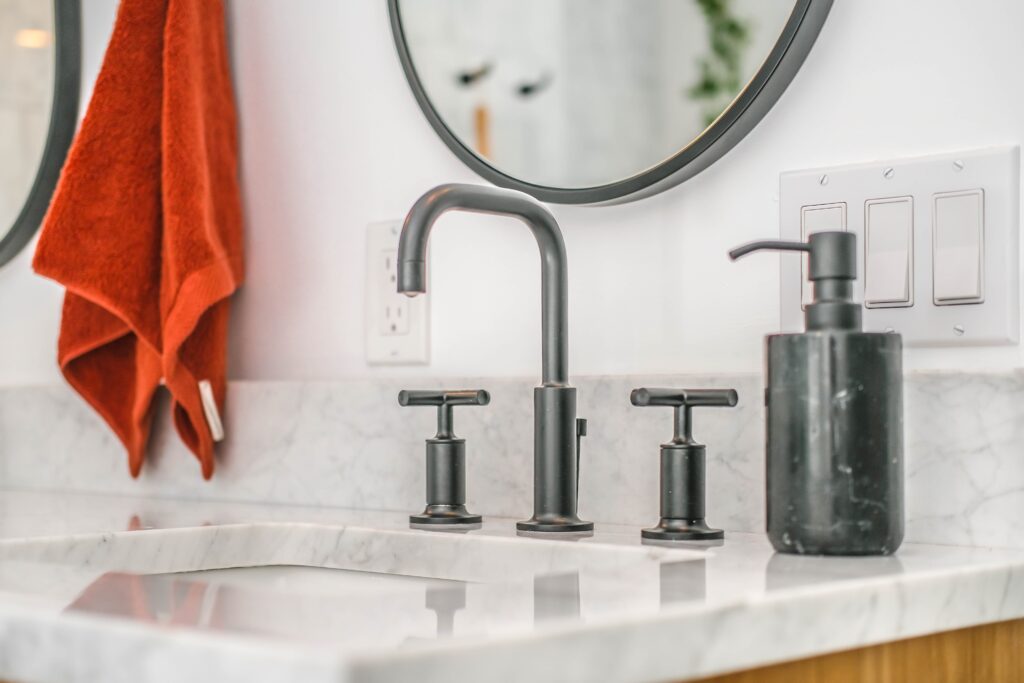
Drip, drop, tick, tock… does your faucet keep you up at night? Is it the sounds they make or the uncertainty of why they’re making them that’s keeping you from a good night’s rest?
Don’t worry! Whether in your house or apartment, a leaking faucet produces incessant ringing and does more than drive you up the wall. It keeps many homeowners awake at night.
A faucet dripping isn’t harmless. It’s annoying and poses financial and health risks. If you don’t fix a leaky faucet immediately, it can deplete your water supply and run up your water bill. Dripping water from public or shared-faucet leaks may also be hazardous to your health.
No one can live without a faucet, so call for professional assistance if your faucet is dripping. It also helps to familiarize yourself with this integral part of your home’s structure.
What Causes Leaky Faucets?
Here’s a quick rundown of the most common causes of leaky faucets:
- Corrosion
- Defective parts
- Mineral deposits
- Improper installment
- Negligence
Let’s discuss where each stems from and how to know which one you’re dealing with.
Your home’s water pressure can corrode faucet parts over time. Although, it isn’t always just the pressure. While it may expedite the corrosion, water flow alone can’t cause corrosion. There may be mineral deposits in faucet pipelines instigating corrosion.
Mineral deposits include calcium, which isn’t typically harmful. However, too many deposits left untreated for too long results in deterioration. This is especially true for improperly installed faucets, pieced together with defective parts. It’s best not to go too long without a thorough inspection. That negligence will cost you in the long run.
Leaky Faucets: Signs & Symptoms
More than one leaky faucet left untreated in houses that aren’t occupied will result in gallons of water being wasted. It’s bad for the environment and that financial burden is no joke. Find a way to resolve your leaking faucet immediately if you notice any of these signs.
How To Determine if There’s a Leak
A leaky faucet is dripping around the clock, but it may start with minor trickling that lasts a few minutes after shutting off the valve.
Sometimes, it can be tricky to tell, but you can attach a plastic bag and secure it to the faucet’s spout area with tape overnight. If you notice at least half of the bag filled, you can be sure your faucet is dripping and call for professional plumbing services.
You can also choose our reliable leak-detection services to save you the time and trouble of figuring it out yourself. If you rely on us for your plumbing matters, we’ll verify whether there’s a leak, help resolve it, find the source of the leak, and conduct the necessary repairs.
The Four Different Types of Faucets
A worse problem to have is dealing with more than one dripping faucet. Depending on what kinds of faucets you have, they may flow at different rates.
Some faucets leak in a waterfall fashion, while others leak slower. Below is a breakdown of the four kinds of faucets you might find in your home.
What Does Your Faucet Spout Look Like?
Is the tip of your faucet round, flat, or wide? Is its stem long, short, or stout? Regardless of your faucet type, the water pressure will determine the leak rate. However, different faucets have varying inlet and outlet seals, and their stopping power impacts the expended volume.
Here’s how you can tell which type of faucet you have.
Cartridge Faucets
Cartridge faucets are some of the most traditional types still available. Their bodies are stout with protruding necks. Like most faucets, a cartridge faucet has handles, rings, screws, an aerator, a valve, and a spout. However, what sets them apart are their cartridges within the vessel.
A cartridge faucet has two cartridge parts:
- Cartridge
- Cartridge stem
The cartridge controls water pressure in and out of the faucet. If it has a corroded valve seat, the cartridge can’t effectively seal gaps to stop water from coming out.
The cartridge stem screw rotates, unlike another type of stem screw that goes up and down. Water sediments also leave behind mineral deposits and disrupt components within the valve seat.
Compression Faucets
A compression faucet is most likely attached to your bathtub or shower. It doesn’t have a body, but its stem is linked straight to the pipeline, leading to the spout directly above the basin or shower floor.
A compression mechanism has a washer attached to the valve stem to control the flow. A worn-out washer could result in a leaking faucet.
Disc Faucets
Newer faucets like the disc faucet look much like a cartridge faucet but angle upward instead of straight. Like cartridge faucets, its handles control a ceramic disc up and down the valve seat to open and shut water release. The small disc can collect water sediments but is more resistant to corrosion than o-rings.
Ceramic discs are sealed in place by an o-ring, but a corroded valve can create gaps between the disc and ring. O-rings are found in nearly all plumbing fixtures, but a loose o-ring is more common in disc faucets.
Ball faucets
The rotary ball faucet has its faucet handle attached to the body like a disc type. They are most commonly installed in the kitchen sink and are more affordable but less reliable.
Sometimes, corrosion with its internal parts isn’t the cause of your leaky faucet. Your dripping faucet may be thanks to worn-out rubber washers in the valve seat. An expanded washer can prevent the total closure of your faucet’s handle.
Faucet Parts
While we’ve mentioned some parts above, we’ll talk more about the role they may play in your faucet, potentially dripping over a hundred gallons of water according to your latest water bill.
That’s an exaggeration, but leaving a house unchecked with active plumbing fixtures can turn it into a swimming pool if you’re not careful. Before we discuss specific parts, let’s talk about some of the most common causes behind all that wasted water.
What Parts Are Most Prone to Causing a Leaky Faucet?
The most common causes of leaky faucets often depend on structural factors. Remember to keep these questions in mind:
- Was your faucet installed properly?
- Do you keep up with routine maintenance?
- Do you have habits you’re unaware of that are causing damage?
If a plumber installed your faucet incorrectly, that’s some structural damage you need to remedy as soon as possible. Incorrect installation includes the mismatching of different parts.
These mismatched parts need to be replaced at the first sign of a problem to keep them from worsening or causing extensive damage. Some contractors use cost-cutting methods, installing faulty components at the building or homeowner’s expense.
Neglecting your plumbing’s upkeep over time is another leading cause of leaky faucets. Many homeowners fail to see the importance of annual inspection and maintenance. A professional plumber can tell you whether it’s a structural defect or regular wear and tear. Whatever the case, it’s best to have it evaluated by a professional plumber.
Don’t forget that you can’t just trust anyone with your plumbing fixtures. Even your local plumber or amateur “fix it” person may take you around the block with unreliable parts and costs.
You should know everything that goes into your faucets before entrusting them to anyone else. Listed below are the most critical parts of your faucet and their role in preventing or causing a leaky faucet.
Valve Seat
The valve seat sits within the stem and holds the compression between different mechanisms, facilitating input and output flow. If you don’t check the valve seat regularly, corrosion may spread and cause more damage.
Any corrosion may lead to gaps and abrasions, compromising its ability to facilitate water correctly.
O-Ring
Dripping water may indicate a faulty o-ring somewhere in the system. While they’re made of sturdy rubber, getting them in the wrong size as replacement parts may affect its operations.
You can resolve these issues by tightening an adjusting ring, but you must replace a fixed o-ring with the correct size. A washer relying on a bad o-ring will constantly leak and wear out much faster.
Washer
Corrosion is highly infectious, and if it’s the kind that’s volatile enough to affect your nylon or polyethylene washer, then it’s more hazardous to its surrounding components. A worn-out washer results in leaks and poses more dangers to your sink.
Packing Nut
A packing nut is lesser-known, but it’s one of the easiest to repair and maintain. It plays a critical role in the entire setup. A packing nut fits vital parts together, and its corrosion or displacement will warrant repair immediately.
When the Water Goes, Call the Pros!
When your sink goes “drip drip” at all hours of the night, it can be more than frustrating. The answer may lie beyond your reach if you’ve tried it all to no avail. You don’t have to go through it alone. Remember, you can tighten loose parts, but broken parts must be replaced.
Whatever your plumbing needs, we have the experts for you.
Mac 5 Services: Plumbing, Cooling, Electric, Heating, Drains
If you need a professional plumber to entrust your worries to, don’t just call anyone. Our team of specialists carries out reliable and efficient plumbing repairs.
If it’s time to retire your old fixtures, we have plumbing replacements that will help take the stress away, paired with our plumbing maintenance benefits, and you can rely on your systems better for longer.
Call (321) 244-7500 today to schedule service.




No Comments yet!